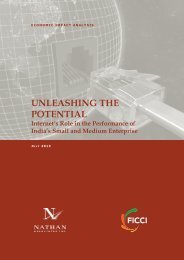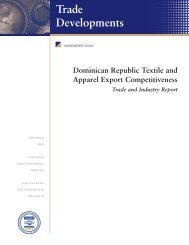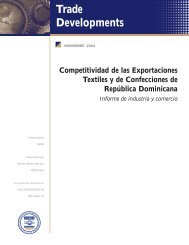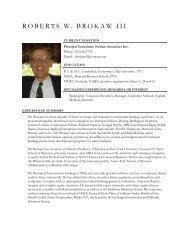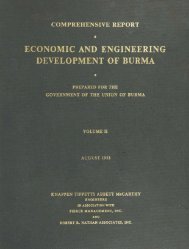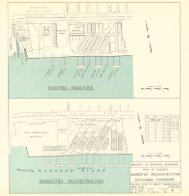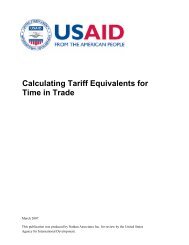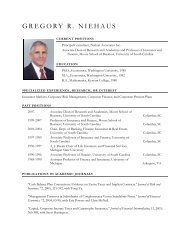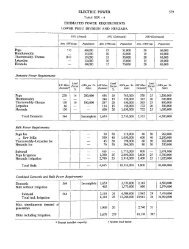Putting it to Work in Developing Countries - Nathan Associates
Putting it to Work in Developing Countries - Nathan Associates
Putting it to Work in Developing Countries - Nathan Associates
Create successful ePaper yourself
Turn your PDF publications into a flip-book with our unique Google optimized e-Paper software.
Three Global Variables <strong>in</strong> FDI Flows<br />
Macroeconomic cond<strong>it</strong>ions. Over the past 30<br />
years, peaks and valleys <strong>in</strong> world FDI have<br />
more or less co<strong>in</strong>cided w<strong>it</strong>h global GDP<br />
growth. Good economic prospects raise confidence<br />
and stimulate <strong>in</strong>vestment of all<br />
k<strong>in</strong>ds, <strong>in</strong>clud<strong>in</strong>g FDI. Past slumps <strong>in</strong> FDI<br />
<strong>in</strong>flows occurred <strong>in</strong> 1976, 1982–1983,<br />
1991, and <strong>in</strong> 2000–2003. Real rates of<br />
global GDP <strong>in</strong>crease fell at about the same<br />
time. The pattern appears tighter <strong>in</strong> the<br />
developed world than <strong>in</strong> the develop<strong>in</strong>g<br />
one. Dur<strong>in</strong>g periods of global economic<br />
stress, developed country mult<strong>in</strong>ationals<br />
seek<strong>in</strong>g <strong>to</strong> cut costs cont<strong>in</strong>ue <strong>to</strong> channel<br />
some FDI <strong>to</strong> develop<strong>in</strong>g countries.<br />
Microeconomic forces. Movements <strong>in</strong> corporate<br />
prof<strong>it</strong>s affect FDI: <strong>in</strong> boom times, they<br />
provide resources and opportun<strong>it</strong>ies for<br />
FDI, and the reverse <strong>in</strong> bust periods. Lower<br />
corporate prof<strong>it</strong>s may also translate <strong>in</strong><strong>to</strong><br />
decl<strong>in</strong><strong>in</strong>g s<strong>to</strong>ck market valuations for<br />
mult<strong>in</strong>ationals, <strong>in</strong> turn putt<strong>in</strong>g pressure on<br />
debt-equ<strong>it</strong>y ratios run up dur<strong>in</strong>g economic<br />
expansions, and accelerat<strong>in</strong>g repayment of<br />
<strong>in</strong>tracompany loans. This reduces FDI<br />
<strong>in</strong>flows. Lower equ<strong>it</strong>y values tied <strong>to</strong> s<strong>to</strong>ck<br />
market dips also discourage mergers and<br />
acquis<strong>it</strong>ions.<br />
Inst<strong>it</strong>utional fac<strong>to</strong>rs. Trade policy and<br />
<strong>in</strong>vestment climate liberalization and regula<strong>to</strong>ry<br />
reform strongly encourage FDI.<br />
Privatization programs <strong>in</strong> the 1990s, especially<br />
<strong>in</strong> Lat<strong>in</strong> America, Eastern Europe, and<br />
the Former Soviet Union, were a major<br />
<strong>in</strong>st<strong>it</strong>utional boost <strong>to</strong> FDI. The rapid rise <strong>in</strong><br />
private participation <strong>in</strong> <strong>in</strong>frastructure<br />
(BOTs, BOOs, etc.) <strong>in</strong> Asia was another.<br />
W<strong>it</strong>h the end of large privatizations and<br />
<strong>in</strong>ves<strong>to</strong>rs’ reawaken<strong>in</strong>g <strong>to</strong> emerg<strong>in</strong>g market<br />
risk after the Asian F<strong>in</strong>ancial Crisis privatizations<br />
and <strong>in</strong>frastructure-related FDI both<br />
dropped off sharply. See UNCTAD, WIR<br />
2003, pp. 15-19. World Bank, GDF 2004,<br />
pp. 154-161.<br />
Table 3-3<br />
Summary of Total FDI Inflows <strong>to</strong> the Develop<strong>in</strong>g World, by Region, 2000-2005 (US$ billion)<br />
Region 2000-2005 2000 2001 2002 2003 2004 2005<br />
East Asia and the Pacific<br />
380.3 47.5 50.5 60.2 60.1 72.2 89.7<br />
Europe and Central Asia<br />
284.9 30.2 32.9 35.0 36.9 68.7 81.2<br />
Lat<strong>in</strong> America and the Caribbean 374.2 79.7 70.6 51.0 42.8 61.6 68.4<br />
Middle East and North Africa 49.7 5.3 6.8 5.5 8.5 7.8 15.8<br />
South Asia<br />
40.9 4.7 6.4 7.0 5.7 7.3 9.8<br />
Sub-Saharan Africa<br />
78.8 6.5 15.0 9.8 14.5 12.8 20.2<br />
Total<br />
1,208.8 174.0 182.2 168.5 168.6 230.4 285.1<br />
Notes: Includes only economies classified as low or middle <strong>in</strong>come by the World Bank (2005 per cap<strong>it</strong>a GNI was $10,725 or less).<br />
SOURCES: UNCTAD, World Investment Report 2006 for data on FDI <strong>in</strong>flows; World Bank, World Development Report 2007 for<br />
regional group<strong>in</strong>gs.<br />
31



